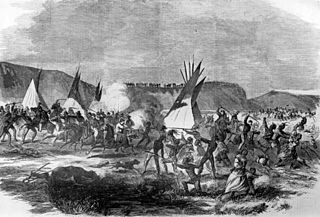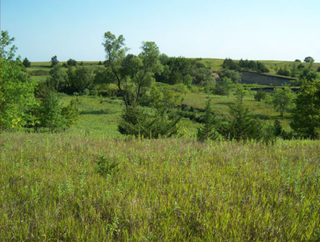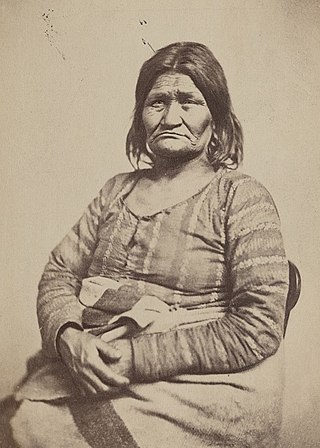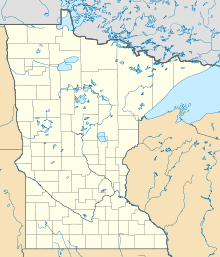
Red Cloud was a leader of the Oglala Lakota from 1868 to 1909. He was one of the most capable Native American opponents whom the United States Army faced in the western territories. He defeated the United States during Red Cloud's War, which was a fight over control of the Powder River Country in northeastern Wyoming and southern Montana. The largest action of the war was the Fetterman Fight, with 81 US soldiers killed; it was the worst military defeat suffered by the US Army on the Great Plains until the Battle of the Little Bighorn 10 years later.

The Battle of Killdeer Mountain took place during Brig. Gen. Alfred Sully's expedition against the Sioux in Dakota Territory July 28–29, 1864. The location of the battleground is in modern Dunn County, North Dakota. With a total of more than 4,000 soldiers involved in the total operation, and more than 2,000 in the battle, Sully's expedition was the largest ever carried out by the U.S. army against Native Americans.

The Battle of Fort Ridgely was an early battle in the Dakota War of 1862. As the closest U.S. military post to the the Lower Sioux Agency, the lightly-fortified Fort Ridgely quickly became both a destination for refugees and a target of Dakota warbands after the attack at the Lower Sioux Agency. It came under attack by the Dakota on August 20, 1862, two days after a company of soldiers responding from the fort to the attack on the Lower Sioux Agency had been ambushed and defeated at the Battle of Redwood Ferry. The Dakota besieged and partially destroyed the fort, but were unable to storm it before the August 27 arrival of Colonel Henry Sibley with 1400 men from Fort Snelling prompted them to retreat.

The Sioux Wars were a series of conflicts between the United States and various subgroups of the Sioux people which occurred in the later half of the 19th century. The earliest conflict came in 1854 when a fight broke out at Fort Laramie in Wyoming, when Sioux warriors killed 31 American soldiers in the Grattan Fight, and the final came in 1890 during the Ghost Dance War.

Fort Ridgely was a frontier United States Army outpost from 1851 to 1867, built 1853–1854 in Minnesota Territory. The Sioux called it Esa Tonka. It was located overlooking the Minnesota river southwest of Fairfax, Minnesota. Half of the fort's land was part of the south reservation in the Minnesota river valley for the Mdewakanton and Wahpekute tribes. Fort Ridgely had no defensive wall, palisade, or guard towers. The Army referred to the fort as the "New Post on the Upper Minnesota" until it was named for three Maryland Army Officers named Ridgely, who died during the Mexican–American War.

The Lower Sioux Agency, or Redwood Agency, was the federal administrative center for the Lower Sioux Indian Reservation in what became Redwood County, Minnesota, United States. It was the site of the Battle of Lower Sioux Agency on August 18, 1862, the first organized battle of the Dakota War of 1862.

The Battle of Whitestone Hill was the culmination of the 1863 operations against the Sioux or Dakota people in Dakota Territory. Brigadier General Alfred Sully attacked a village September 3–5, 1863. The Native Americans in the village included Yanktonai, Santee, and Teton (Lakota) Sioux. Sully killed, wounded, or captured 300 to 400 Sioux, including women and children, at a cost of about 60 casualties. Sully would continue the conflict with another campaign in 1864.

Big Eagle was the chief of a band of Mdewakanton Dakota in Minnesota. He played an important role as a military leader in the Dakota War of 1862. Big Eagle surrendered soon after the Battle of Wood Lake and was sentenced to death and imprisoned, but was pardoned by President Abraham Lincoln in 1864. Big Eagle's narrative, "A Sioux Story of the War" was first published in 1894, and is one of the most widely cited first-person accounts of the 1862 war in Minnesota from a Dakota point of view.
William Othello Wilson was an African-American corporal in the United States Army's 9th Cavalry Regiment. He is noted for having received the Medal of Honor.

Fort Abercrombie, in North Dakota, was an American fort established by authority of an act of Congress, March 3, 1857. The act allocated twenty-five square miles of land on the Red River of the North in Dakota Territory to be used for a military outpost, but the exact location was left to the discretion of Lieutenant Colonel John J. Abercrombie. The fort was constructed in the year 1858. It was the first permanent military settlement in what became North Dakota, and is thus known as "The Gateway to the Dakotas".

The Battle of Wood Lake occurred on September 23, 1862, and was the final battle in the Dakota War of 1862. The two-hour battle, which actually took place at nearby Lone Tree Lake, was a decisive victory for the U.S. forces led by Colonel Henry Hastings Sibley. With heavy casualties inflicted on the Dakota forces led by Chief Little Crow, the "hostile" Dakota warriors dispersed. Little Crow and 150 followers fled for the northern plains, while other Mdewakantons quietly joined the "friendly" Dakota camp started by the Sisseton and Wahpeton bands, which would soon become known as Camp Release.

The Battle of Birch Coulee occurred September 2–3, 1862 and resulted in the heaviest casualties suffered by U.S. forces during the Dakota War of 1862. The battle occurred after a group of Dakota warriors followed a U.S. burial expedition, including volunteer infantry, mounted guards and civilians, to an exposed plain where they were setting up camp. That night, 200 Dakota soldiers surrounded the camp and ambushed the Birch Coulee campsite in the early morning, commencing a siege that lasted for over 30 hours, until the arrival of reinforcements and artillery led by Colonel Henry Hastings Sibley.

The Attack at the Lower Sioux Agency was the first organized attack led by Dakota leader Little Crow in Minnesota on August 18, 1862 and is considered the initial engagement of the Dakota War of 1862. It resulted in 13 settler deaths, with seven more killed while fleeing the agency for Fort Ridgely.

The Battles of New Ulm, also known as the New Ulm Massacre, were two battles in August 1862 between Dakota men and European settlers and militia in New Ulm, Minnesota. They were part of the Dakota War of 1862. The Dakota forces attacked New Ulm on August 19 and again on August 23. After the second attack, the town was evacuated.

The Dakota War of 1862, also known as the Sioux Uprising, the Dakota Uprising, the Sioux Outbreak of 1862, the Dakota Conflict, the U.S.-Dakota War of 1862, or Little Crow's War, was an armed conflict between the United States and several bands of eastern Dakota also known as the Santee Sioux. It began on August 18, 1862, at the Lower Sioux Agency along the Minnesota River in southwest Minnesota.

The Sisseton Wahpeton Oyate of the Lake Traverse Reservation, formerly Sisseton-Wahpeton Sioux Tribe/Dakota Nation, is a federally recognized tribe comprising two bands and two subdivisions of the Isanti or Santee Dakota people. They are on the Lake Traverse Reservation in northeast South Dakota.
Shakopee or Chief Shakopee may refer to one of at least three Mdewakanton Dakota leaders who lived in the area that became Minnesota from the late 18th century through 1865. The name comes from the Dakota Śakpe meaning "Six." According to tribal histories, the very first "Shakpe" was called that because he was the sixth child of a set of sextuplets.
Acton is an unincorporated community in Acton Township, Meeker County, Minnesota, United States, near Grove City and Litchfield. The community is located along Meeker County Road 23 near State Highway 4. County Road 32 is also in the immediate area.

Fort Ripley was a United States Army outpost on the upper Mississippi River, in mid-central Minnesota from 1848 to 1877. It was situated a few miles from the Indian agencies for the Ho-Chunk and Ojibwe in Iowa Territory and then the Minnesota Territory. Its presence spurred immigration into the area and the pioneer settlement of Crow Wing developed approximately 6.75 miles north of the fort. The post was initially named Fort Marcy. It then was renamed Fort Gaines and in 1850 was renamed again for distinguished Brigadier General Eleazer Wheelock Ripley of the War of 1812. It was the second major military reservation established in what would become Minnesota.

Azayamankawin, also known as Hazaiyankawin, Betsey St. Clair, Old Bets, or Old Betz, was one of the most photographed Native American women of the 19th century. She was a Mdewakanton Dakota woman well known in Saint Paul, Minnesota, where she once ran a canoe ferry service. Old Bets was said to have helped many women and children taken captive during the Dakota War of 1862.



















